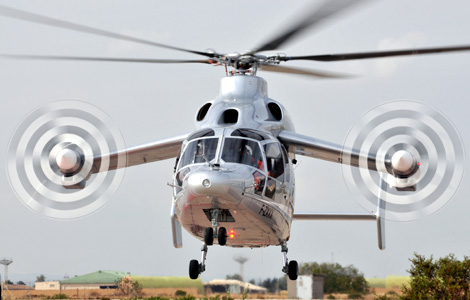Helicopter speeds have traditionally been limited by a phenomenon called “retreating blade stall,” which describes what happens to the main rotor at high speed. The relative wind on the retreating blade is reduced by the forward speed of the helicopter to a point where it no longer generates lift, and the helicopter rolls off to the side with reduced lift.
Tilt-rotor vehicles like the Bell Boeing Osprey turn the rotor blades into propellers. Now a less complex solution that dates back several decades is re-emerging: the compound helicopter, which uses a dedicated propulsor to produce forward speed. The Piasecki X-49A modified a Sikorsky UH-60 with a lifting surface made up of two wings, plus a ducted fan in the tail to push the aircraft to speeds of around 200 mph. The wings take up part of the lift load so the main rotor doesn’t have to provide as much at high speeds, and blade stall no longer matters as much.
The Eurocopter X3 is a modified EC155, itself a derivative of that company’s Dauphin (the U.S. Coast Guard operates one version). The X3 has achieved speed bursts as high as 267 mph, propelled by two tractor propellers driven by the main engines and mounted on stubby wings just beneath the main rotor. At high speed, the six-blade main rotor is slowed to reduce the drag of the advancing blade, while the wings provide necessary lift.
Sikorsky’s X-2 has advanced far enough to become the proof-of-concept for a prototype military aircraft now designated the S-97 Raider, a high-speed attack and scout helicopter. The X-2 proved the efficacy of a coaxial main rotor blade in which both sides of the helicopter have advancing blades opposite retreating blades, providing a symmetrical lift that requires no wing. Forward thrust is provided by a pusher propeller in the tail, an arrangement that took the experimental craft to a top speed of 290 mph, and, in a descent, to 300 mph. There is no tail rotor à la the traditional helicopter, and the X-2 maneuvers about the yaw axis by applying differential torque to the two main rotors. The little X-2 (it weighed less than 8,000 pounds on takeoff) was retired after only 22 hours of flying.
The X-2 is not Sikorsky’s first compound helicopter. Its S-72 employed a fixed wing and two turbofan engines to achieve a design speed of up to 345 mph. The wing generated enough lift to allow the craft to fly without a main rotor, which it actually did during testing. The X-Wing, another 1980s experimental craft, employed large, rigid main rotor blades that were intended to be stopped inflight to form an X-shape wing that supplemented lift from a conventional wing. Two turbofans provided thrust.
The closest the U.S. military came to buying and operating a compound helicopter was when it launched the Lockheed AH-56 Cheyenne with a contract in 1966 for 10 prototypes. Problems and delays during development led to cancellation of the Cheyenne, but the Army followed that with the AH-64 Apache, which is not a compound helicopter but is in operation today.
Here’s a demo of Eurocopter’s X-3 at last summer’s Paris Air Show:




0 comments:
Post a Comment